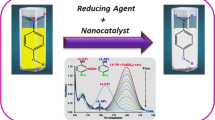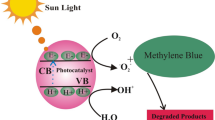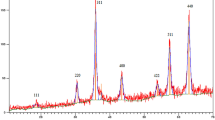Abstract
New self-assembled material (Ru@SC) with ruthenium nanoparticles (Ru NPs) and 4-sulfocalix[4]arene (SC) is synthesized in water at room temperature. Ru@SC is characterized by thermal gravimetric analysis, FT-IR, powder x-ray diffraction, TEM and SEM analysis. The size of Ru nanoparticles in the self-assembly is approximately 5 nm. The self-assembled material Ru@SC shows an efficient catalytic reduction of toxic ‘brilliant yellow’ (BY) azo dye. The reduced amine products were successfully separated and confirmed by single-crystal XRD, NMR and UV-Vis spectroscopy. Ru@SC showed a better catalytic activity in comparison with commercial catalysts Ru/C (ruthenium on charcoal 5 %) and Pd/C (palladium on charcoal 5 and 10 %). The catalyst also showed a promising recyclability and heterogeneous nature as a catalyst for reduction of ‘BY’ azo dye.

ᅟ







Similar content being viewed by others
References
Akbayrak S, Ozkar S (2012) Ruthenium(0) nanoparticles supported on multiwalled carbon nanotube as highly active catalyst for hydrogen generation from Ammonia–Borane. ACS Appl Mater Interfaces 4:6302–6310
Akbayrak S, Ozkar S (2014) Ruthenium(0) nanoparticles supported on xonotlite nanowire: a long-lived catalyst for hydrolytic dehydrogenation of ammonia-borane. Dalton Trans 43:1797–1805
Ball P, Nicholls CH (1982) Azo-hydrazone tautomerism of hydroxyazo compounds a review. Dyes Pigments 3:5–26
Ben-Ishay ML, Gedanken A (2007) Difference in the bonding scheme of calix(6)arene and p–sulfonic calix[6]arene to nanoparticles of Fe2O3 and Fe3O4. Langmuir 23:5238–5242
Biswas A, Paul S, Banerjee A (2015) Carbon nanodots, Ru nanodots and hybrid nanodots: preparation and catalytic properties. J Mater Chem A 3:15074–15081
Carrillo AI, Schmidt LC, Marin ML, Scaiano JC (2014) Mild synthesis of mesoporous silica supported ruthenium nanoparticles as heterogeneous catalysts in oxidative Wittig coupling reactions. Catal Sci Technol 4:435–440
Cervantes FJ, Espinosa AG, Moreno-Reynosa MA, Rangel-Mendez JR (2010) Immobilized redox mediators on anion exchange resins and their role on the reductive decolorization of azo dyes. Environ Sci Technol 44:1747–1753
Chang G, Luo Y, Lu W, Qin X, Asiri AM, Al-Youbi AO, Sun X (2012) Ag nanoparticles decorated polyaniline nanofibers: synthesis, characterization, and applications toward catalytic reduction of 4-nitrophenol and electrochemical detection of H2O2 and glucose. Catal Sci Technol 2:800–806
Chen M, Diao GW, Zhou XM (2007) Formation of nanospheres of cuprous oxide with a bridge linker of p-sulfonated calix[8]arene host. Nanotechnology 18:275606–275615
Chen X-C, Tao T, Wang Y-G, Peng Y-X, Huang W, Qian H-F (2012) Azo-hydrazone tautomerism observed from UV-Vis spectra by pH control and metal-ion complexation for two heterocyclic disperse yellow dyes. Dalton Trans 41:11107–11115
Cheng K, Kang J, Huang S, You Z, Zhang Q, Ding J, Hua W, Lou Y, Deng W, Wang Y (2012) Mesoporous beta zeolite-supported ruthenium nanoparticles for selective conversion of synthesis gas to C5–C11 isoparaffins. ACS Catal 2:441–449
Fernandez J, Bandara J, Lopez A, Buffat P, Kiwi J (1999) Photoassisted fenton degradation of nonbiodegradable azo dye (orange II) in Fe-free solutions mediated by cation transfer membranes. Langmuir 15:185–192
Gao S, Zhang J, Zhu Y-F, Che C-M (2000) A convenient solvothermal route to ruthenium nanoparticles. New J Chem 24:739–740
Guo D-S, Liu Y (2012) Calixarene-based supramolecular polymerization in solution. Chem Soc Rev 41:5907–5921
Guo D-S, Wang K, Wang Y-X, Liu Y (2012) Cholinesterase-responsive supramolecular vesicle. J Am Chem Soc 134:10244–10250
Habibi MH, Hassanzadeh A, Mahdavi S (2005) The effect of operational parameters on the photocatalytic degradation of three textile azo dyes in aqueous TiO2 suspensions. J Photochem Photobiol A 172:89–96
Herbois R, Noel S, Leger B, Tilloy S, Menuel S, Addad A, Martel B, Ponchela A, Monflier E (2015) Ruthenium-containing β-cyclodextrin polymer globules for the catalytic hydrogenation of biomass-derived furanic compounds. Green Chem 17:2444–2454
Hu C, Hu XX, Wang LS, Qu JH, Wang AM (2006) Visible-light-induced photocatalytic degradation of azodyes in aqueous AgI/TiO2 dispersion. Environ Sci Technol 40:7903–7907
Hubble LJ, Clark TE, Makhaa M, Raston CL (2008) Selective diameter uptake of single-walled carbon nanotubes in water using phosphonated calixarenes and ‘extended arm’ sulfonated calixarenes. J Mater Chem 18:5961–5966
Huc V, Pelzer K (2008) A new specifically designed calix[8]arene for the synthesis of functionalized, nanometric and subnanometric Pd, Pt and Ru nanoparticles. J Colloid Interface Sci 318:1–4
Jagwani JS, Lakshmi B, Sharma MC (2013) Isolation and identification of a bacterial consortium for biodegradation of a textile dye reactive orange M2R and study of phytotoxicity of the degraded product on Phaseolus mungo and Triticum aestivum. Global Res Analysis 2:83–86
Janus M, Morawski AW (2007) New method of improving photocatalytic activity of commercial Degussa P25 for azo dyes decomposition. Appl Catal B 75:118–123
Jiang H-Y, Zheng X-X (2015) Tuning the chemoselective hydrogenation of aromatic ketones, aromatic aldehydes and quinolines catalyzed by phosphine functionalized ionic liquid stabilized ruthenium nanoparticles. Catal Sci Technol 5:3728–3734
Kannan P, John SA (2011) Fabrication of conducting polymer-gold nanoparticles film on electrodes using monolayer protected gold nanoparticles and its electrocatalytic application. Electrochim Acta 56:7029–7037
Knackmuss HJ (1996) Basic knowledge and perspectives of bioelimination of xenobiotic compounds. J Biotechnol 51:287–295
Kuberan T, Anburaj J, Sundaravadivelan C, Kumar P (2011) Biodegradation of azo dye by Listeria sp. Int J Environ Sci 1:1760–1768
Lee M, Amaratunga P, Kim J, Lee D (2010) TiO2 nanoparticle photocatalysts modified with monolayer-protected gold clusters. J Phys Chem C 114:18366–18371
Lee J, Shim HS, Lee M, Song JK, Lee D (2011) Size-controlled electron transfer and photocatalytic activity of ZnO–Au nanoparticle composites. J Phys Chem Lett 2:2840–2845
Liu GM, Li XZ, Zhao JC (2000) Photooxidation pathway of Sulforhodamine-B. Dependence on the adsorption mode on TiO2 exposed to visible light radiation. Environ Sci Technol 34:3982–3990
Liu J, Zhang LL, Zhang J, Liuc T, Zhao XS (2013) Bimetallic ruthenium–copper nanoparticles embedded in mesoporous carbon as an effective hydrogenation catalyst. Nanoscale 5:11044–11050
Mao X, Tian D, Li H (2012) P-sulfonated calix[6]arene modified graphene as a ‘turn on’ fluorescent probe for L-carnitine in living cells. Chem Commun 48:4851–4853
Martinez-Prieto LM, Carenco S, Wu CH, Bonnefille E, Axnanda S, Liu Z, Fazzini PF, Karine Philippot K, Salmeron M, Chaudret B (2014) Organometallic ruthenium nanoparticles as model catalysts for CO hydrogenation: a nuclear magnetic resonance and ambient-pressure x-ray photoelectron spectroscopy study. ACS Catal 4:3160–3168
Merino E, Ribagorda M (2012) Control over molecular motion using the cis–trans photoisomerization of the azo group. Beilstein J Org Chem 8:1071–1090
Ogoshi T, Yamagishi T, Nakamoto Y (2007) Supramolecular single-walled carbon nanotubes (SWCNTs) network polymer made by hybrids of SWCNTs and water-soluble calix[8]arenes. Chem Commun :4776–4778
Pengfei J, Zhang J, Chen F, Anpo M (2009) Study of adsorption and degradation of acid orange 7 on the surface of CeO2 under visible light irradiation. Appl Catal B 85:148–154
Pereira WS, Freire RS (2006) Azo dye degradation by recycled waste zero-valent iron powder. J Braz Chem Soc 17:832–838
Pradhan AC, Parida KM, Nanda B (2011) Enhanced photocatalytic and adsorptive degradation of organic dyes by mesoporous Cu/Al2O3–MCM-41: intra-particle mesoporosity, electron transfer and OH radical generation under visible light. Dalton Trans 40:7348–7356
Rajesh R, Kumar SS, Venkatesan R (2014) Efficient degradation of azo dyes using Ag and Au nanoparticles stabilized on graphene oxide functionalized with PAMAM dendrimers. New J Chem 38:1551–1558
Rambabu D, Pooja, Pradeep CP, Dhir A (2016a) Al3+–phenanthroline xerogel for dual application: catalyst for knoevenagel condensation and fluorescent chemosensor for azo dyes. ChemistrySelect 1:3371–3376
Rambabu D, Pradeep CP, Dhir A (2016b) Nickel–sodium pyrene tetrasulfonic acid based co-ordination polymer as fluorescent template for recognition of azo dyes. Sensors Actuators B Chem 225:586–592
Rieger PG, Meir HM, Gerle M, Vogt U, Groth T, Knackmuss HJ (2002) Xenobiotics in the environment: present and future strategies to obviate the problem of biological persistence. J Biotechnol 94:101–123
Rollas S (2010) Reduction of aromatic and heteroaromatic azo compounds with hydrazine hydrate. Marmara Pharm J 14:41–46
Sahasrabudhe MM, Pathade GR (2011) Decolourization of C.I. reactive yellow 145 by enterococcus faecalis strain YZ66. Arch Appl Sci Res 3:403–414
Sahasrabudhe M, Pathade G (2013) Biodegradation of azo dye C.I. reactive orange 16 by an actinobacterium Georgenia sp. CC-NMPT-T3. Int J Adv Res 1:91–99
Sarmah PP, Dutta DK (2012) Chemoselective reduction of a nitro group through transfer hydrogenation catalysed by Ru0-nanoparticles stabilized on modified montmorillonite clay. Green Chem 14:1086–1093
Shinkai S, Araki K, Matsuda T, Nishiyama N, Ikeda H, Takusu I, Iwamoto M (1990) NMR and crystallographic studies of a p-sulfonatocalix[4]arene-guest complex. J Am Chem Soc 112:9053–9058
Singh SK, Xu Q (2013) Nanocatalysts for hydrogen generation from hydrazine. Catal Sci Technol 3:1889–1900
Singh SK, Zhang X-B, Xu Q (2009) Room-temperature hydrogen generation from hydrous hydrazine for chemical hydrogen storage. J Am Chem Soc 131:9894–9895
Tandon SA, Shaikh S, Kumar R (2014) Development and use of soil bacterial consortia for bioremediation of dye polluted soil and municipal waste water. G J Biosci Biotech 3:284–291
Wang Y-X, Zhang Y-M, Liu Y (2015) Photolysis of an amphiphilic assembly by Calixarene-induced aggregation. J Am Chem Soc 137:4543–4549
Xiong D, Chen M, Li H (2008) Synthesis of para-sulfonatocalix[4]arene-modified silver nanoparticles as colorimetric histidine probes. Chem Commun :880–882
Zhang H, Chen D, Xiaojun LV, Wang Y, Chang H, Li J (2010) Energy-efficient photodegradation of azo dyes with TiO2 nanoparticles based on photoisomerization and alternate UV−visible light. Environ Sci Technol 44:1107–1111
Zhang J, Xiong Z, Zhao XS (2011) Graphene–metal–oxide composites for the degradation of dyes under visible light irradiation. J Mater Chem 21:3634–3640
Zhou J, Chen M, Diao G (2013) Calix[4,6,8]arenesulfonates functionalized reduced graphene oxide with high supramolecular recognition capability: fabrication and application for enhanced host–guest electrochemical recognition. ACS Appl Mater Interfaces 5:828–836
Zhu L, Yang Z, Zheng J, Hu W, Zhang N, Li Y, Zhong CJ, Ye H, Chen BH (2015) Decoration of Co/Co3O4 nanoparticles with Ru nanoclusters: a new strategy for design of highly active hydrogenation. J Mater Chem A 3:11716–11719
Zollinger H (1987) Colour chemistry-synthesis, properties and applications of organic dyes and pigments. VCH Publishers, New York, pp. 92–102
Acknowledgements
AD acknowledges the Department of Science and Technology India for INSPIRE faculty award and Advance Material Research Centre (AMRC) IIT Mandi for instrumentation and laboratory facilities. DRB acknowledges the Council of Scientific and Industrial Research (CSIR), India, for fellowship. DRB acknowledges Mr. Prateep Singh Sagara and Mr. Ashish Bahuguna for the helping in NMR analysis.
Author information
Authors and Affiliations
Corresponding author
Ethics declarations
Conflict of interest
The authors declare that they have no conflict of interest.
Electronic supplementary material
ESM 1
(DOCX 10875 kb)
Rights and permissions
About this article
Cite this article
Rambabu, D., Pradeep, C.P. & Dhir, A. New self-assembled material based on Ru nanoparticles and 4-sulfocalix[4]arene as an efficient and recyclable catalyst for reduction of brilliant yellow azo dye in water: a new model catalytic reaction. J Nanopart Res 18, 381 (2016). https://doi.org/10.1007/s11051-016-3693-6
Received:
Accepted:
Published:
DOI: https://doi.org/10.1007/s11051-016-3693-6




